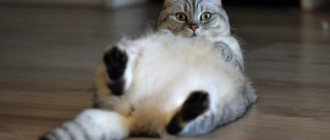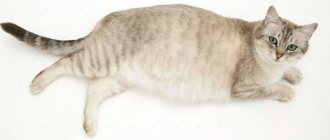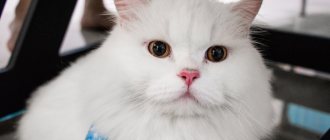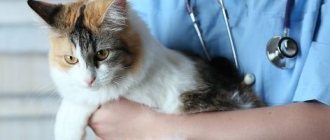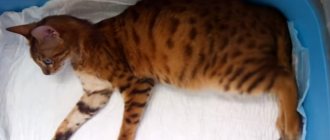Scottish cats are ideal mustachioed friends for any person. They have many undeniable qualities: cleanliness, calm disposition, unobtrusiveness, the ability to exist peacefully with other pets. Scottish cats are especially good-natured, which is why female cats so often start families. Scottish boys, as a rule, have a more independent character and prefer to keep the owner and other family members at a distance.
At first, when the Scottish girl is very small, the owner does not have any special problems. It is important to choose the right diet, take care of timely vaccination against severe infectious diseases, and the general health of the pet. But already from adolescence, when the animal is 8 months old, the owner will have to face a choice: whether to allow the pet to give birth to kittens or to deprive her of motherhood. If you still plan to mate a cat with a male, then the owner will certainly be faced with questions about the pregnancy of his pet. At what age can a pet be allowed to breed? How long does pregnancy last in Scottish cats, what are the symptoms of an “interesting” situation? How to behave correctly if there is a cat in the house expecting offspring? We will be looking for answers to these questions.
How long does pregnancy last in Scottish cats?
The condition of a pregnant cat directly depends on environmental conditions, the presence or absence of stress factors. In unfavorable conditions, the duration of pregnancy in Scottish Folds can be reduced to 58 days, but this has a detrimental effect on the health of future babies.
A healthy representative of the Scottish Fold breed usually bears cubs for 60 to 65 days. When the owner of a Scottish Fold cat asks the doctor how long the animal’s pregnancy lasts, he should be ready to talk about the health and behavioral characteristics of his pet. The duration of gestation of kittens depends on many conditions:
- the presence or absence of obesity in the expectant mother;
- age: young Scottish Folds (up to a year) often encounter problems when bearing kittens;
- intensity of hormonal fluctuations;
- the presence of infectious diseases: a sick mother may give birth to premature kittens or have a miscarriage.
Important! With a large number of embryos, labor begins earlier. Cases have been recorded when expectant mothers with many children (3 or more kittens) gave birth to offspring after 60 days of pregnancy.
Very rarely, pregnant Scottish Fold cats go 70–75 days before giving birth. This happens due to genetic predisposition or individual characteristics of the body.
Circumstances on which the duration of gestation depends
The duration of pregnancy in cats of long-haired breeds, as a rule, is longer (from 58 to 72 days) than in short-haired and hairless cats (58-68 days).
How long a pet can walk while pregnant also depends on the number of cubs in her womb. When there are few of them, the duration will be longer, and when the number of babies exceeds five, the birth will be delivered a little earlier.
It is considered normal when the period is delayed by one week, and the mother and babies feel good. When resolution of the burden does not occur for a longer time, you should consult a specialist. In such a situation, the owner needs to be aware of exactly when fertilization occurred (it takes place approximately a day or a day and a half after the cat mates with the male).
We invite you to read: Ketosteril for cats: instructions for use, indications and side effects
When contractions begin 7 days ahead of schedule, then, unfortunately, the babies may not survive. Even if their number reaches 12, this period is too early for a successful outcome.
The duration of pregnancy can also be affected by the emotional state at the end of the term. A negative attitude delays childbirth.
The female’s belonging to a certain breed also affects the duration. For example, Siamese cats stay pregnant longer than other cats. See how many months a cat goes pregnant.
Preparing a Scottish woman for pregnancy
Before planning a breeding, the owner of a Scottish Fold cat should know when she might go into heat. As a rule, this happens in the 9th month of the furry beauty’s life. But mating during this period is not recommended. This age is considered a period of early sexual maturity: the animal’s body has not yet fully matured. It is better to postpone this event until the age of one year, or at least until the 3rd heat.
Before becoming pregnant, a Scottish Fold cat must:
- Provide the expectant mother with a fortified diet.
- Treat your pet against external and internal parasites.
- Give the animal vaccinations.
- Choose and equip a warm and secluded place without drafts for the future family, and accustom the cat to it in advance.
- Pay attention to the health of the future father of newborn babies.
Important! The way a Scottish woman eats cannot be changed after pregnancy. If the food was dry, then it should be fed to the expectant mother, subject to the veterinarian’s recommendations.
What owners should do and what not to do to preserve the gestation period of their offspring
In order for the cat to emerge within the prescribed period, the owners need to know several rules about what should be done and what should be avoided during this period, so that the duration does not change towards critical. Rules are not a panacea, because There is also a genetic predisposition, which “you can’t argue with.
What do we have to do:
- Contact a specialist as soon as possible after the expected conception to identify possible risks to the life and health of the fetus and for the mother cat. It is wise to use an ultrasound to find out if the cat is pregnant at all.
- Contact your veterinarian if Murka exhibits any strange behavior or changes in health (vomiting, fever, lack of appetite).
- Protect the pet from children so that they do not squeeze, kick or make any sudden movements towards the animal.
- Provide balanced and sufficient nutrition.
- If necessary, give vitamins for pregnant women (veterinary).
What not to do:
- Make Murka nervous. This includes purchasing new pets during this period, arranging noisy events indoors where the cat cannot hide, and allowing children in.
- Press the stomach tightly, supposedly trying to determine how many babies should be born. It is almost impossible to do this with your hands, especially for a non-specialist, and it is easy to injure the abdomen!
- Give any medications without consulting a veterinarian.
- Allow Murka to jump from a height or climb there.
- Washing or treating your home with strong and strong-smelling household chemical solutions is a direct path to poisoning.
- Allow contact with sick and abandoned animals.
- Do not follow the rules of hygiene (stroking with dirty hands after going outside or allowing you to sleep in the shoes you came in from the street in).
How to detect early pregnancy
As a rule, signs of pregnancy in a Scottish Fold cat can only be diagnosed after 2-3 weeks. But they are individual for each animal and may not be noticeable in the early stages.
Modern science does not yet have tests to determine the fact of fertilization in animals. Symptoms that indicate your pet is pregnant:
- morning sickness;
- swelling of the nipples, change in their color (they turn pink);
- increased appetite;
- change in food preferences;
- changing habits;
- tendency to apathy;
- increasing the duration of sleep periods.
Important! Due to the genetic characteristics of the Scottish Fold breed, they mate exclusively with straight-eared partners (Scottish Straight). This practice guarantees the birth of healthy and strong offspring.
Nuances and possible complications
Scottish Fold cats that bear kittens require special supervision from the owner. To avoid complications and maintain the health of the furry beauty and her offspring, the owner of the animal should invite a veterinarian if he notices the following symptoms:
- complete lack of appetite in the cat for more than 2 days at the beginning or middle of pregnancy;
- the appearance of discharge long before birth;
- fever, lethargy;
- the gestational age exceeded 68 days.
Attention! If labor begins in a cat 2-5 days earlier, you need to call a doctor at home.
False pregnancy
Each Scottish Fold has its own type of nervous organization and individual hormonal background. Under the influence of unfavorable factors, symptoms of a so-called false pregnancy may develop:
- the appearance of discharge from the vulva;
- frequent licking;
- enlargement of the abdomen and nipples;
- onset of lactation;
- increased and then decreased appetite;
- bowel disorders.
Treatment in this case is prescribed only by a doctor. Before contacting a specialist, you should limit your cat's intake of milk and reduce food portions.
Frozen pregnancy
The viability of the cubs is determined by the doctor after 2 weeks after fertilization. If there is a suspicion that the embryos have died, the animal is given an ultrasound.
The causes of missed abortion are usually infectious diseases, hormonal disorders, and pathological processes. Not all embryos may die, and then they do not interfere during pregnancy, and the mother gives birth to non-viable cubs along with the living ones.
If a Scottish Fold cat is diagnosed with a frozen pregnancy with complete death of kittens, the animal is induced to give birth and all pregnant cubs are removed. This must be done to save the mother from infection with decomposition products. If postoperative complications develop, the animal is sterilized.
Superfetation
Scottish Fold cats can go into heat even if they are already pregnant. Repeated sexual contact with the same partner (superfetation) in such animals leads to the beginning of a parallel process - a second pregnancy. It occurs simultaneously with the first. Another male can also fertilize a cat for the second time - this is called superfecundation.
In most cases, this situation ends badly - with a miscarriage or the death of one of the litters. Even if a cat carries and manages to give birth to all the cubs, it will be very difficult for her to feed the offspring. Therefore, it is very important to isolate the expectant mother from adult cats.
What are the dangers of early pregnancy?
Despite the fact that teenage cats are physiologically capable of giving birth as early as 7–8 months, experts recommend against mating such young animals. Scottish Fold cats that are under one year of age often give birth to weak or dead kittens, no matter how much care they take.
After such stress, the animal takes a long time to recover, rarely recovering earlier than after 6 months. If a cat develops complications due to an unsuccessful birth, she will need long-term therapy, and possibly sterilization.
Features of the first pregnancy
Pregnant Scottish women behave very carefully, avoiding conflicts and active games. They do not strive to go outside and instinctively limit their physical activity.
Primiparous animals require additional attention. It is very important to properly organize your pet’s nutrition:
- feed several times a day in small portions;
- use specialized feed;
- control the animal’s weight and avoid overfeeding.
Do not be surprised if at 8 weeks of pregnancy the expectant mother begins to look for a place for a nest. In her desire to make herself more comfortable, she can create a mess in her wardrobe. A loving owner prepares a bed for the future family in advance and accustoms the cat to it.
Interesting! If a primiparous cat at 9 weeks of pregnancy does not eat for a day or two, there is no need to panic. This is how the animal prepares for childbirth.
What is not allowed in an “interesting position”?
A cat's behavior changes during pregnancy, and you need to change your attitude towards it a little. What a cat should not do in this situation:
- jumping from heights can be dangerous;
- cannot be treated against fleas and helminths;
- do not give medications without consulting a veterinarian, they can harm the kittens;
- Do not feed spoiled food;
- do not drink tap water;
- pick it up carefully.
If a cat has always walked outside, you shouldn’t prohibit it from doing so now. When the due date approaches, she will be at home more often.
Pregnancy calendar for Scottish cats by week
An experienced veterinarian can diagnose the onset of pregnancy in a domestic Scottish female within 14 days after fertilization. If you know the exact date of mating, you can easily determine the stages of development of the process.
The entire period of pregnancy of a Scottish fold cat is conventionally divided into 3 parts (trimesters):
- The first one is up to 3 weeks. The cat refuses its usual treats and vomits in the morning. The appearance of the animal remains unchanged.
- Second – 4–6 weeks. Fluctuations in hormonal levels begin, which causes bursts of unusual animal behavior (aggression or, on the contrary, an excessive need for affection). The cat's belly becomes rounder, it begins to eat more, and its weight increases. The physical activity of the animal is noticeably reduced.
- The third – from 6 weeks until birth. The expectant mother is increasingly showing anxiety and likes to settle down in secluded places to rest. The size of the abdomen increases, the nipples swell greatly. If you put your hand on the stomach, you can feel the kittens move. At week 9, colostrum appears.
While the Scottish female is bearing offspring, she needs special treatment: it is not recommended to pick her up or allow her to climb onto high surfaces. The cat must be provided with a high-calorie and balanced diet.
General information about the duration of gestation
On average, the question “how long does a cat stay pregnant?” The most frequently heard answer is 2 months. However, this is a rather loose concept - some individuals barely carry their offspring to term for up to 60 days, and for some the process can last up to 70. According to general estimates, the minimum gestation period for cats is from 56 to 60 days, the maximum normal is considered to be 71 days (some sources give 72 days). These are periods when the birth of viable offspring is allowed. Most often - 64-67 days (roughly rounded, it comes out to 9 weeks).
The entire “pregnant” period is conventionally divided into 3 phases of development, each of which on average includes 3 weeks.
1 phase
This period lasts from the moment of expected conception to 21 days. During this period, eggs are fertilized and embryos develop. By the 15th day, the embryo already becomes up to 1 cm in size, by the 18th day the paws appear, and by the end of the period the internal organs are already formed. It is in this phase that active pinking of the nipples is observed.
2 phase
During this period (from 22 to 42 days), the brain, skeletal structure, muscles and endocrine system are actively formed and developed. From this point on, the kittens are called fetuses, taking on the classic feline appearance with a clearly defined muzzle and genitals. Only after a month of pregnancy the cat’s belly begins to grow a little.
3 phase
On days 43-63 from the moment of conception, kittens, growing to 8-10 cm, acquire a tail and acquire a coat with a certain color. By the middle of the period, their size reaches 13 cm, by the 57th day they are already fully formed and developed babies who are ready to be born at any moment.
There are exceptions to all rules. The duration may vary depending on many factors:
- offspring of purebred individuals born before 60 days are most often non-viable;
- cats with a slender constitution (subtle) usually never go pregnant longer than 65 days (on average it is 60-65 days), and fat and well-fed ones usually carry a pregnancy and the period can reach 70-72 days;
- primiparous cats, especially those who become pregnant during their first heat before the age of 1 year, in most cases give birth earlier than the expected average period (up to 60 days). Kittens are not always born viable and are often weak and small. That is why experienced breeders do not recommend mating a cat to produce offspring in the first heat and under the age of one year;
- primiparous middle-aged cats bear their offspring somewhat longer than their female peers who have given birth;
- yard outbred cats bear less fruit than domestic and special breed cats. Sometimes healthy babies are born on the 55th day - this indicates better endurance and higher adaptability of street individuals compared to domestic ones;
- in a fold cat (British, Scottish), kittens are gestated for an average of 63-67 days, but almost never less than 60 days;
- cases of nursing up to 75 days have been recorded. The course of the entire period was without complications, and the newborns were all alive and well. The reasons for such a long but safe gestation are still a mystery to veterinarians;
- Pregnancy of the Maine Coon breed is usually longer than that of other breeds - up to 68 days or 9 full weeks in preparation for the birth of the cat herself;
- long-haired cats stay pregnant longer (up to 70 days) than smooth-haired or completely hairless cats (around 65 days);
- the fewer fruits there are in the litter, the longer the cat can go pregnant and, conversely, the more, the faster and more often the birth will occur before the due date;
- weather conditions affect the onset of labor - sudden changes in temperature and environmental humidity can suddenly trigger premature birth;
- The pregnancy of a Scottish cat is usually shorter than that of a British cat, in which the pregnancy period can sometimes increase to 70-72 days. Therefore, there is no clear answer to the questions of how long pregnancy lasts in a Scottish cat or how long pregnancy lasts in a British cat - variations in duration are present here too.
( 2 ratings, average 4.5 out of 5 )
Caring for a pregnant cat
It is necessary to try to eliminate factors that cause stress from the animal’s life. For example, if before pregnancy a Scottish fold cat walked freely alone, you should not prohibit her from such walks during pregnancy.
You cannot treat an animal with chemicals without a veterinarian’s prescription or vaccinate it. This can have a detrimental effect on the health of both mother and offspring.
The food must be exclusively fresh. From the second trimester of pregnancy, portions begin to gradually increase, this continues until the end of the first month. Then the amount of feed is gradually reduced until the initial volume is reached by week 9.
Important! A pregnant cat's meals should be divided, she is fed 5 times a day.
If the expectant mother is accustomed to a natural diet , it needs to be diversified with vegetables, herbs, vegetable oil, cereals, and eggs. From time to time you can pamper your cat with sea fish (pre-boiled). Rabbit, veal, and poultry are very healthy. It is allowed to support your pet’s body with multivitamins.
There are ready-made foods for pregnant cats on the market. The Scottish cat needs exactly these products if she initially ate dry formulas. It is better to purchase extra-premium food.
For your information! Treating cats for parasites during pregnancy is prohibited.
Preparing for childbirth
In a house where a Scottish woman expecting offspring lives, you should not rearrange the furniture or play loud music. Purchasing new pets is also undesirable. All this will irritate the cat and can provoke premature birth. The litter in the cat corner needs to be changed regularly.
It is necessary to enlist the support of a veterinarian so that in case of an unforeseen situation he can go to your home.
As a rule, cats cope with childbirth on their own. But a weakened Scottish woman or a Scottish woman giving birth for the first time may need help. At the time of birth, it is worth preparing some tools: scissors (to cut the umbilical cord), iodine to disinfect the wound, an old diaper (to wipe kittens), a small syringe to remove mucus from the noses of newborns.
Assistance during childbirth
It is impossible to determine exactly how long pregnancy lasts in Scottish Fold cats. The process continues until the cubs are fully mature. A harbinger of the onset of labor is a decrease in the cat's rectal temperature. This happens about a day or 12 hours before birth.
When the water breaks and contractions begin, the owner of the animal should be nearby to help the woman in labor if necessary. The cat should be placed on a clean cloth with a diaper placed under it, and the tools should be prepared. A warm heating pad and Vaseline may be needed.
If the process is going slowly, you need to help the cat: lightly pull the cub by the withers when its head and shoulder blades become visible. Hands should be pre-treated with Vaseline.
After the birth of the first baby, its umbilical cord is cut 2 cm from the abdomen, tied with thread and the wound is disinfected. The babies are placed next to the mother's nipples so that she can lick them and feed them. Fed kittens are wiped with a dry cloth and placed on a clean towel, under which there is a warm heating pad.
If a cat cannot deliver the placenta on its own, the owner must remove it. In case of prolonged (more than 20 hours) and inconclusive contractions, you need to invite a doctor. After the birth is completed, it will not be superfluous to count the placenta: there should be as many of them as newborn kittens.
To protect the mother and babies from stress, it is advisable to postpone receiving guests and moving for the lactation period until the kittens are stronger. The family needs peace and temporary isolation from other animals and children.
Regardless of the amount of time that Scottish Fold cats brood, their kittens may be born healthy or weak. The main factors that influence the success of the business are the health of the expectant mother and her owner’s awareness of the rules of proper care for a pregnant cat. An affectionate attitude towards the animal and the organization of a calm and cozy environment for the future cat family play a huge role.
Hygiene of newborn Scots
After giving birth, the mother cat herself licks and cleans the kittens from the intrauterine membrane, and then eats it along with the afterbirth. But if she doesn’t do this, then you need to carefully tear the film yourself and free the baby.
This should be done with clean, disinfected hands. Next, put the kittens in a diaper and let them dry. The eyes can be wiped with a cotton swab dipped in warm water. Remove mucus from the nose with a pipette.
After birth, it is necessary to provide the kittens with a cozy and warm home. It should be spacious enough for mother and cubs to sit comfortably there.
A large, tall cardboard box or a cozy spot at the bottom of a closet would be ideal. You can also purchase a cat house from a pet store.
In the place where the kittens will lie, you need to lay a clean sheet, blanket or warm blanket. In newborn Scottish Folds, the process of thermoregulation has not yet been established, so it is necessary to maintain the temperature in the place where the babies lie.
It should be no lower than 25C. To do this, you can place a heater nearby or place a heating pad next to the kittens.
